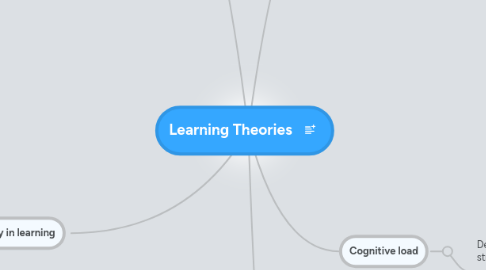
1. Connectivism
1.1. Using networks
1.1.1. Using already existant information to increase knowledge helps the learning process
1.2. Connectedness
1.2.1. Linking of cognition and emotion
1.2.2. Connections help nurture learning, more so than learning individual concepts in isolation from each other
1.3. Updated Information
1.3.1. Learning is active, there maybe changes in information that lead to changes in the validity of responses
2. Technology in learning
2.1. Media Ecology
2.1.1. Technology shapes the environment
2.1.1.1. Humans are therefor shaped by the technology that surronds them
2.1.1.2. Influences society
2.2. SCOT
2.2.1. Founded on the premise that people shape their technological environment (opposes Media Ecology)
2.2.2. The worth of technology is determined by how society views it
2.2.2.1. Can provide a definition of relative social success of a technology
2.3. Teachnology
2.3.1. A philosophy that ties teachers personal views with the use of technology in an educational setting
2.3.1.1. Very dependant of how teachers see themselves using, interacting and teaching with technology
2.3.1.1.1. This can include Personal Learning Networks
2.3.1.2. How technology is used in the classroom as a learning tool
2.4. TPACK
2.4.1. The perfect combination of three components in learning
2.4.1.1. Technologicl Knowledge
2.4.1.1.1. Confidence in technology, ability to share this with students
2.4.1.2. Pedagogical Knowledge
2.4.1.2.1. Classroom strategies, management theories, learning theories and the standards set for grading
2.4.1.3. Content Knowledge
2.4.1.3.1. Knowledgable about the course subject, mastery of ideas and confidence in the subject area
2.4.2. There are subdivisions that account for a lack of perfect integration
2.4.2.1. TPK
2.4.2.1.1. When technology and pedagogy work together
2.4.2.2. TCK
2.4.2.2.1. The intersection of technology and content knowledge
2.4.2.3. PCK
2.4.2.3.1. Pedagogical and content knowledge coming together
3. Constructivism
3.1. Knowledge and learning are active
3.1.1. Current knowledge adds to our ability to gain new knowledge
3.2. Learning requires adaptation
3.2.1. People will either adapt the schema they currently have to meet the new qualifications, or assimilate the new information into their current one
3.3. Prominent thinkers
3.3.1. Lee Vygotsky
3.3.1.1. Zone of proximal development, states that there is an area that we learn best in between what we already know and is easy, and information that is difficult and out of our reach intellectually.
3.3.1.2. Culture affects learning
3.3.2. Jean Piaget
3.3.2.1. Knowledge is impacted by the learning environment
3.4. Effects in the classroom
3.4.1. Active discussion between students and teachers
3.4.2. Help develop creative thinking
3.4.3. Less teacher dominant
4. Behaviorism
4.1. beliefs are based on a subjects responses to stimuli
4.1.1. Applying positive or negative reinforcement to get the desired result
4.2. Supporters
4.2.1. B. F. Skinner
4.2.1.1. Belief in the reward system to encourage behavioiurs
4.2.2. Ian Pavlov
4.2.2.1. Famous experiment with dog salivation in response to a bell ringing
4.3. Learning through observation
4.4. Implications for the classroom
4.4.1. More rote memorization and repetition drills
5. Cognitive load
5.1. Defines the limits that our brain structure can hold
5.1.1. Working memory vs long term memory
5.1.1.1. Working memory has a smaller capacity, and can store approximately 7 different items
5.1.1.1.1. When an idea is tranfered from working to long term memory, a schema is created
5.1.1.2. Long term memory is virtually unlimited
5.1.2. Types of Cognitive loads
5.1.2.1. Germane
5.1.2.1.1. Helps with processing information and creating schemas.
5.1.2.2. Intrinsic
5.1.2.2.1. When the brain is overwhelmed by the task itself, this occurs.
5.1.2.3. Extraneous
5.1.2.3.1. Occurs when the brain becomes overwhelmed by the way that the information is presented
5.1.3. Strategies to get the most out of our capacity
5.1.3.1. Chunking the content into groups that are easy to remember
5.1.3.2. Pneumonic devices
5.1.3.3. Remove information that is extraneous as it detracts from the overall understanding
